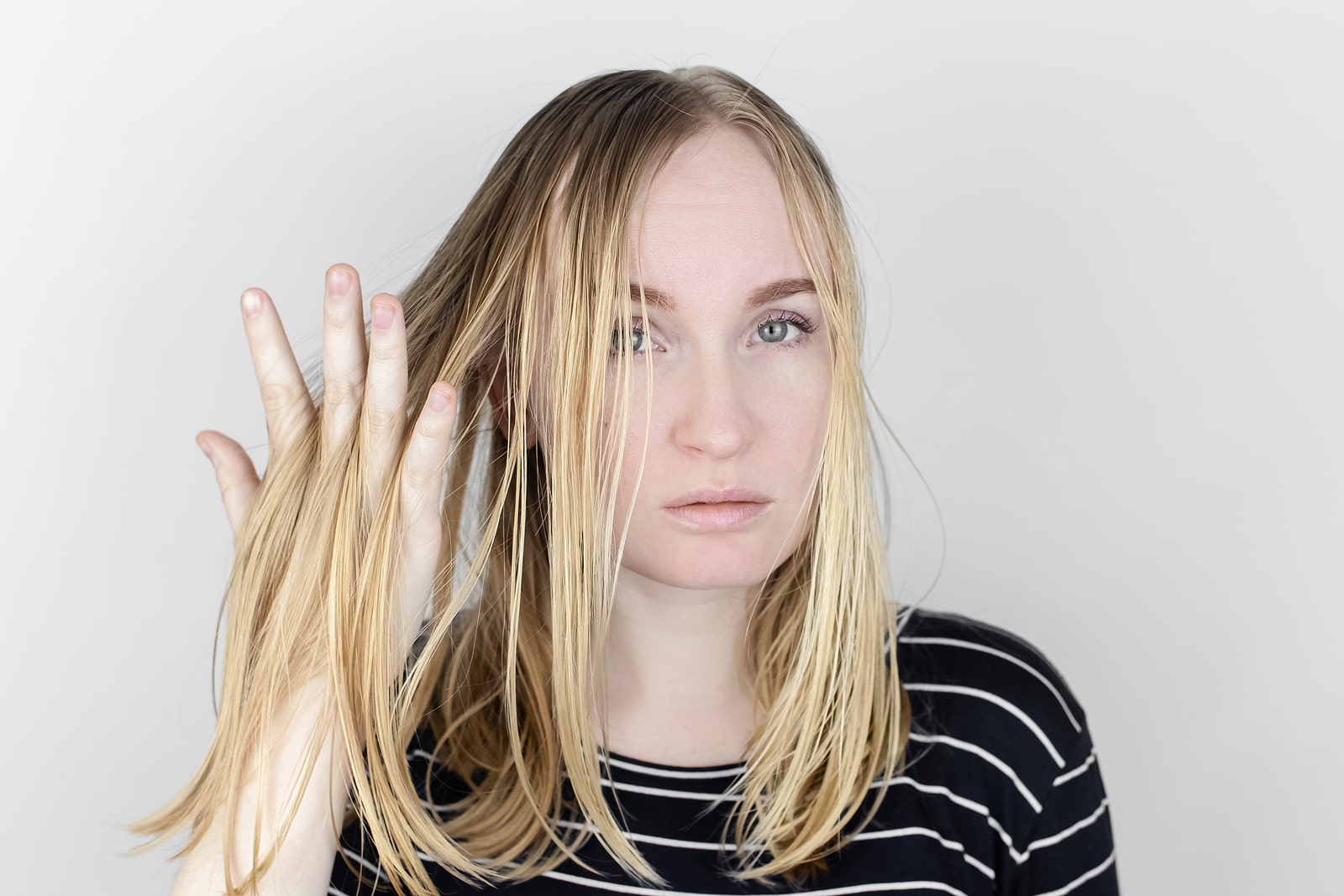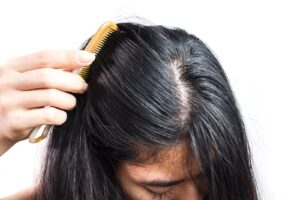Oily hair is extremely common. In fact, it is considered one of the four main types of hair conditioning, and is usually caused by the build-up of the secretion from the sebaceous glands in the scalp. People of virtually all demographics and with any hair type may experience oily hair. It can be uncomfortable, unhealthy, and difficult to style. Fortunately, there are preventative measures you can take to manage oily hair and keep it as light and fresh as possible.
What Causes Oily Hair?
There are a number of different factors that can contribute to greasy hair. According to stylist Linda de Zeeuw, “Greasy hair is the result of overactive sebaceous glands when they are producing too much sebum. Although sebum is good for the hair, too much can make your hair look slick and greasy. Common causes of oily hair are unhealthy eating habits, medications, improper hair care, stress, hormonal fluctuations, and change in weather.”
Identifying the cause of your oily hair is an important first step in addressing the problem. If your hair isn’t usually greasy, it could be due to a stressful life event or a lack of attention to proper hair washing and hygiene. Alternatively, many people simply have oilier hair, and it can be managed via healthful habits and the use of quality products.
Sudden Greasy Hair
Moisturizing Products
If your hair is suddenly greasy, you might be using products that are not compatible with your hair. Moisture is important for all hair types, but it is entirely possible that you are using products that provide a little too much hydration. This can cause hair to become greasy quickly due to an excess of moisture that the scalp does not need. Try switching to products that have less of an emphasis on hydration and see if your hair’s moisture balance returns. This can include products like hair oils, heat protectants, and conditioners. According to dermatologist Charlotte Birnbaum, “Consider clarifying shampoos that aim to deep cleanse, better reducing residue, oil, and build-up on the scalp.”
Hormonal Shifts
Sebum production is dictated by hormones. Accordingly, a sudden increase in scalp oil production can indicate hormonal changes influenced by life events like puberty, pregnancy, or menopause. These changes usually resolve on their own, but some simple adjustments to your hair care routine can make them more manageable.
Dietary or Hygiene Changes
If you notice a sudden change in your hair’s greasiness. and you have changed your diet recently, this could be the cause. Diets that are high in saturated fats and refined carbohydrates can create an increase in your skin’s natural oil production. Shampooing and rinsing your hair regularly is also important for maintaining healthy sebum levels. If you have been skipping washes and/or rinses more than usual lately, this could be the culprit behind your greasier-than-usual hair. If your hair is bothering you, try making some changes in these areas. Be sure to consult your doctor regarding any serious changes or adjustments that may interact with medications you take. The following foods are believed to help reduce oily skin:
- Grains
- Beans
- Sunflower seeds
- Nuts
- Oats
Naturally Oily Hair
Hair Type
There are natural hair types that are more prone than others to becoming oily. Straight hair, for example, often has a natural tendency to easily get greasy. This is because the hair shaft has no natural wave or curl to it, so the oil slides straight down the shaft and collects on the scalp. This also makes the oiliness more visible and obvious when the hair hangs straight down. Choose products that emphasize lift and volume and try to avoid those that add too much extra weight and moisture.
Genetics
If your parents and other family members are also predisposed to greasy hair, there is a good chance it runs in your family. All people have different skin types, and some people’s skin generates more sebum than others. Sebum is part of the dermal biome that waterproofs the skin and hair and protects it from moisture loss. For some people, sebum is produced naturally at a higher rate. Developing a hair washing schedule that works for your individual hair type and moisture level should help you maintain fresh, clean-feeling hair in the long term.
Managing Oily Hair
Condition the Right Way
If the above doesn’t apply to you, consider whether you are using your conditioner the right way. Conditioner is essential for all hair types for the protection, hydration, and nourishment it provides. However, if you are applying conditioner to your roots, it could be causing an imbalance in moisture levels. Scalps that naturally produce an excess of sebum do not need the extra hydration provided by conditioner. Stick to using your conditioner on the ends of your hair rather than the roots. Make sure you are fully rinsing the conditioner out of your hair after each and every wash.
Shampoo Less Often
Though it sounds counter-intuitive, washing your hair less often can actually help with greasy hair. When you use shampoo, you strip your scalp of its natural sebum. Your body’s response is to replace this oil with more oil, which can cause an overproduction of sebum. This will often turn into a cycle that leaves you with limp, greasy hair over time. Try skipping the shampoo at least twice per week and training your hair over time to adhere to a schedule of washing every other day at most. This will create the conditions for healthy, natural sebum levels that won’t leave your hair feeling itchy, dirty, and uncomfortable.
Change Your Brush
While it is widely believed that brushing oily hair will only make the problem worse, you can actually use specific brushes to remove and redistribute sebum to make roots appear less greasy. Boar bristle brushes are the ideal choice for those with oily hair, as the fibers pick up and redistribute oils throughout the hair. Be careful not to over-brush, which can stimulate the scalp to produce more sebum.
Use a Scalp Scrub
Using a scalp scrub or exfoliant once or twice a week can do wonders when it comes to reducing buildup and fixing oily hair. Find a product with finely-ground textures, such as sugar, and apply it to your scalp when wet. Use small, circular motions to massage the scrub into your scalp. This will clear away dead skin, dirt, and oil buildup, and it refresh your scalp overall.
Contact Us
If you are looking for hair restoration or replacement services, contact Eldorado today. We offer a comprehensive range of hair extensions, human hair wigs, and hair systems in Baltimore. Call 410-469-6077 to schedule your free hair analysis today.




